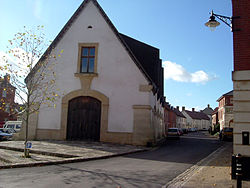Poundbury: Difference between revisions
Created page with "{{Infobox town |name=Poundbury |county=Dorset |picture=Middlemarsh Street - geograph.org.uk - 384233.jpg |picture caption=Middlemarsh Street, Poundbury |os grid ref=SY671549 |..." |
No edit summary |
||
| Line 14: | Line 14: | ||
|constituency=West Dorset | |constituency=West Dorset | ||
}} | }} | ||
'''Poundbury''' is an experimental new town on the outskirts of [[Dorchester]], the county town of [[Dorset]]. It was developed by the Duchy of Cornwall on the personal initiative of the | '''Poundbury''' is an experimental new town on the outskirts of [[Dorchester]], the county town of [[Dorset]]. It was developed by the Duchy of Cornwall on the personal initiative of the King, when Prince of Wales and Duke of Cornwall, and so as to reflect his philosophy of architecture. | ||
The development is built on land owned by the Duchy of Cornwall. It is built according to the principles of Prince Charles, who is known for holding strong views challenging the post-war trends in town planning that were suburban in character. | The development is built on land owned by the Duchy of Cornwall. It is built according to the principles of Prince Charles, who is known for holding strong views challenging the post-war trends in town planning that were suburban in character. | ||
Latest revision as of 17:19, 10 March 2023
| Poundbury | |
| Dorset | |
|---|---|
 Middlemarsh Street, Poundbury | |
| Location | |
| Grid reference: | SY671549 |
| Location: | 50°42’48"N, 2°27’58"W |
| Data | |
| Post town: | Dorchester |
| Postcode: | DT1 |
| Dialling code: | 01305 |
| Local Government | |
| Council: | Dorset |
| Parliamentary constituency: |
West Dorset |
Poundbury is an experimental new town on the outskirts of Dorchester, the county town of Dorset. It was developed by the Duchy of Cornwall on the personal initiative of the King, when Prince of Wales and Duke of Cornwall, and so as to reflect his philosophy of architecture.
The development is built on land owned by the Duchy of Cornwall. It is built according to the principles of Prince Charles, who is known for holding strong views challenging the post-war trends in town planning that were suburban in character.

Plan
The development is built to a traditional high-density urban pattern, rather than a suburban one, focused on creating an integrated community of shops, businesses, and private and social housing. There is no zoning. The planners say they are designing the development around people rather than the automobile, and they aim to provide a high-quality environment, from the architecture to the selection of materials, to the signposts, and the landscaping. To avoid constant construction, utilities are buried in common utility ducts under the town. Common areas are maintained by a management company to which all residents belong.[1]
To some degree, the project shows similarities with the contemporary New Urbanism movement, except that the design influences are more European. The design of the houses are in traditional and new classical styles, with period features such as bricked-up windows, a feature found on many old British buildings.[2]
The overall plan was developed in the late 1980s by the Luxemburgish architect Leon Krier, and construction started in October 1993. Krier's plans have been criticised for mixing too many different continental styles and the use of non-local building materials, which are not consistent with the traditions of Dorchester. It is expected that the four plan phases will be developed over 25 years with a total of 2,500 dwellings and a population of approximately 6,000.
Greetings card entrepreneur Andrew Brownsword sponsored the £1 million development of the market hall at Poundbury, designed by John Simpson and based on early designs, particularly the one in Tetbury.[3]
Following New Urbanist principles, Poundbury was intended to reduce car dependency and encourage walking, cycling, and public transport. A survey conducted at the end of the first phase, however, showed that automobile use was higher in Poundbury than in the surrounding rural areas of westerm Dorset.[4] Nonetheless, the community is receiving positive recognition from New Urbanist publications such as Better Cities and Towns.[5]
Gallery
-
The Whistling Witch
-
Dorset Fire and Rescue Service HQ/Fire station
See also
- Fairford Leys - A very similar project located on the edge of Aylesbury
- Poundbury Hill – an Iron Age hill fort near Poundbury
Outside links
| ("Wikimedia Commons" has material about Poundbury) |
References
- ↑ Pentreath, Ben, How the Poundbury project became a model for innovation, The Financial Times, November 1, 2013
- ↑ "Around Poundbury". BBC Dorset. July 2008. http://www.bbc.co.uk/dorset/content/image_galleries/poundbury_gallery.shtml?18. Retrieved 19 April 2013.
- ↑ Giles Worsley A model village grows up gracefully The Telegraph, 30 January 2011.
- ↑ Watson, G., Bentley, I., Roaf, S., and Smith, P., 2004. Learning from Poundbury, Research for the West Dorset District Council and the Duchy of Cornwall. Oxford Brookes University
- ↑ Steuteville, Robert, At 20, Poundbury is winning converts, Better Cities and Towns, November 5, 2013
- HRH Charles, Prince of Wales: A Vision of Britain: A Personal View of Architecture (Doubleday, 1989) ISBN 0-385-26903-X
- Leon Krier: Architecture: Choice or Fate (Andreas Papadakis Publishers, 1998) ISBN 1-901092-03-8
- Sandy Mitchell. "Prince Charles is not your typical radical." National Geographic. May 2006. [1]

